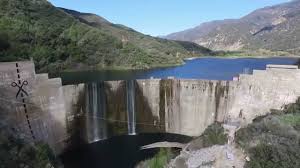Location: Ventura County
Project Type: Restoration Planning
Status: Completed
Habitat Type: fish passage, sedimentation
Cost: $615,000
Assembly District: 37
Senate District: 19
Congressional District: 26
Project Lead/Grantee:
County of Ventura (805-654-5000)
 For more information, visit scwrp.org
For more information, visit scwrp.org
This project performed various studies to evaluate the feasibility of removing Matilija Dam on the Ventura River to restore natual water and sediment flows, and provide access to upstream steelhead trout habitat.
Matilija Dam is responsible for a variety of adverse effects on stream ecology and wildlife. The sediment trapped by the dam has deprived downstream reaches of the sand, gravel, and more coarse-grained materials needed to sustain a suitable substrate for fish, such as riffle and pool formations, sandbars, and secondary channels. The dam has blocked river flows from the upper watershed and altered natural stream and habitat dynamics. Other problems associated with the dam include the loss of riparian and wildlife corridors between the Ventura River and Matilija Creek, and the deteriorating condition of the dam itself. But the two most serious impacts are its effect on steelhead migration and its impacts on the river’s sediment budget.
The dramatic decline of Southern California steelhead trout (Oncorhynchus mykiss), a federally-listed endangered species, is the major issue within the Ventura River watershed. Before Matilija Dam was built, the river ran essentially unimpeded to the ocean, and 4,000 to 5,000 adult steelhead would migrate up the river each year to spawn, comprising one of the largest steelhead runs in the region. Construction of Matilija Dam cutoff access to more than half of the river’s most productive spawning and rearing habitat. Current estimates indicate that less than 100 adult steelhead remain within the Ventura River system. With the removal of Matilija Dam and the implementation of the other components of the Matilija Dam Ecosystem Restoration Project, steelhead and other aquatic species would gain access to 17.3 river miles of high quality habitat upstream. Conversely, upstream fish passage cannot be restored without taking down the dam, since a fish ladder is simply impractical for a dam of this height.

